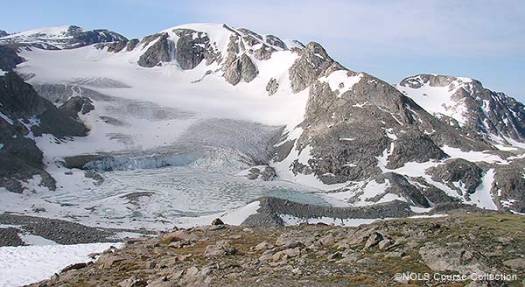I’m writing this just a few days after my return from a NOLS Wilderness Mountaineering course in the Wind River mountains of Wyoming. It was amazing to be away from everything for 30 days. I didn’t know what to expect at first, but I had a great time and I learned a lot. I feel a lot more confident climbing and being in the wilderness now.
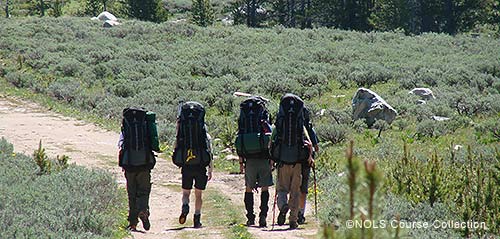
Starting in at Union Pass, last road we’d see for 30 days.
On the 17th of June I arrived in Lander, Wyoming with my parents. That evening I met my instructors and the other students. We spent that night in the Noble, an old hotel that NOLS owns and operates as lodging for students before and after courses. We spent most of the next day getting all of our gear situated. After we got all of our gear and food, we took a bus to the trailhead at Union Pass, on the northern tip of the Winds, and camped there that night.
For the next two days we hiked toward the Continental Divide and then camped two nights below the Divide at Granite Lake. We climbed and fished there a lot, and learned about climbing technique. Next we went up and over the Continental Divide to just above Pinto Lake. We camped for two nights there, and the day in between was spent getting our next ration of food from some horse packers a couple of miles down the trail, and fishing a little.

Some of us got in the fishing right away.
From our camp above Pinto Lake, Three Waters Peak was looming above us. It had a lot of big cornices on it and a couple of them would break every day, making an awesome thundering sound.
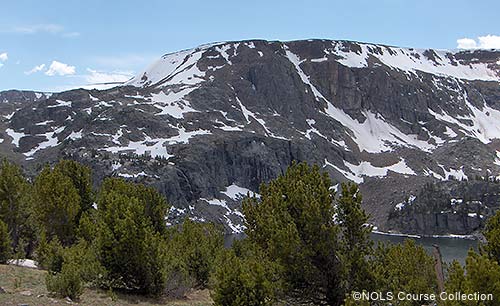
It wasn’t long till we were seeing the alpine, and couloirs that made me want my skis.
After Pinto Lake, we hiked over the Divide again to Dads Lake, a tiny lake above timberline that still had ice on it and quite a bit of snow around it. The weather was windy and cold for most of the time we were at Dads Lake. The next day we went to another lake that was less than a mile away because we thought there might be some steep snow there to practice self-arrest. There didn’t turn out to be any good place to do the self-arrest practice, but it was a cool camp that was almost on top of the Continental Divide.

Wind River lakes such as Granite Lake are always good looking — and frequently full of trout.
The next day we crossed the Continental Glacier, which is about 3 miles long and runs near the top to the Continental Divide. This was the first time I had ever done any glacier travel. It was a little hard because by the end we were post holing (wish I had my skis), but it was cool to be on a glacier and learn how to cross it safely.
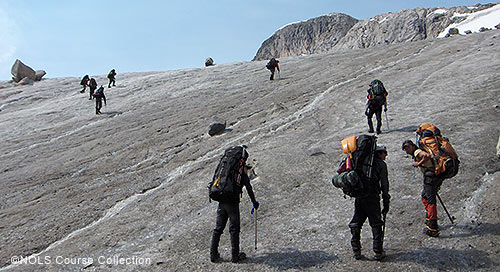
Getting started up Grasshopper Glacier.
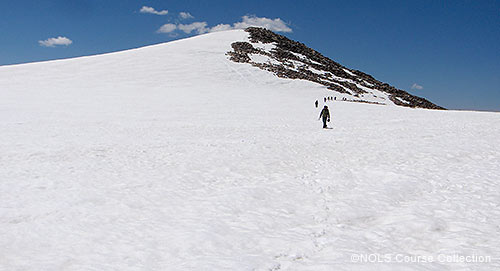
Glacier travel.
After crossing the Continental Glacier we camped at over 13,000 feet on top of the Continental Divide and alongside the glacier. We camped there for two nights, it was a super cool camp, it had a great view of the Winds, and there were steep cliffs off one side and glaciers below them. We learned a bunch of stuff about snow travel and ice ax use at that camp.
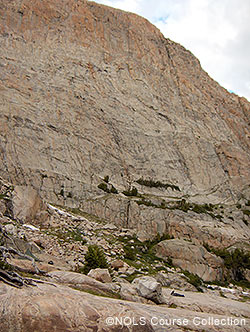
Orange Wall rock climbing area.
We then moved about 5 miles along the Divide to another camp on top of the Divide at Yukon peak. The next day we moved off the Divide to bellow Orange Wall, a huge 1,000 foot cliff that had good climbing on it. We camped there for over a week, during that time we got our third ration of food from a horse packer camp about 7 miles down valley. We did a lot of climbing while we were camped at Orange Wall, everybody also got to do some multi-pitch climbs; one group got to do a 10 pitch climb to the top. When we left Orange Wall, we went up Grasshopper Glacier, which is about 3 miles long, with 1 mile of bare ice at the start.
We camped at a glacier lake at the top of Grasshopper. The lake had a big ice cliff on one side that was really cool, and some people heard part of it falling in the lake during the night. After that we moved into Gannett Cirque, a really amazing glaciated cirque that has a bunch of high peaks in it, including Gannett, the highest peak in Wyoming. We stayed there for a couple of days and climbed Gannett while we were there.
For the Gannett climb we woke up at 12:30 in the morning, got back at 12:00 in the afternoon, and slept for the rest of the day (some people got some pretty gnarly sunburns from sleeping out in the sun). We climbed up Dinwoody Glacier and saw the sun rise over the Wind Rivers from the summit ridge, one of the most beautiful things I’ve ever experienced. We had to do glacier travel and self-belaying with our ice axes to get to the top and we got to do a bunch of glissading on the way down. I’d wanted for years to do real glacier climbing and this was it!
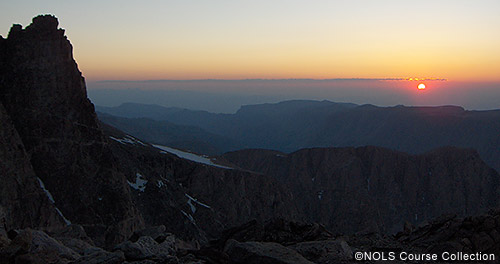
Sunrise from the near the summit of Gannett Peak.
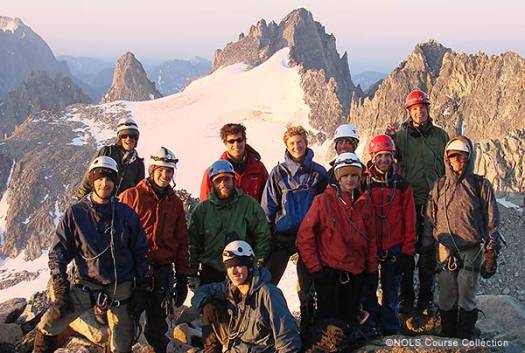
Some of our course on top of Gannett, I’m in the back on the right, white helmet.
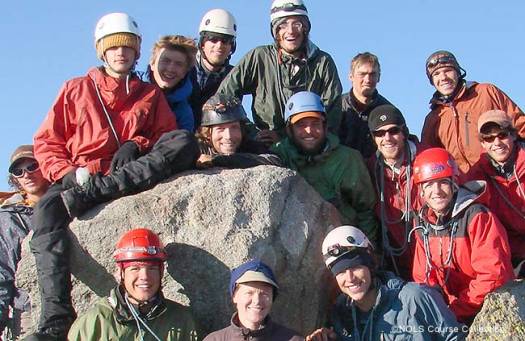
Another Gannett shot, this is a NOLS classic, my dad used to bring his courses up here.
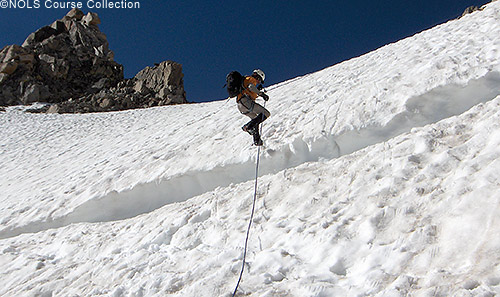
Getting down from Gannett required roping over a bergschrund.
The day after Gannett we headed out of the cirque by hiking up Bonney pass, where we camped for the night. That day we hiked without the instructors for the first time, but met up with them and the other groups at our campsite. The next morning we glissaded down a steep snow slope on the other side of the pass almost to the bottom of the valley. We then camped below another pass we had planed to climb but didn’t because it looked super steep (in reality, it was barely 30 degrees).
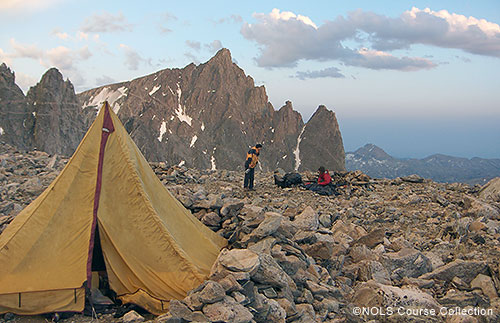
An amazing high camp on Bonney Pass.
The next day we hiked over the “Imposssible” pass and to a camp by Elbow Lake. That day we hiked and camped without the instructors, which we did every night afterwards till the end of the trip. I tried to fish in Elbow Lake but the mosquitoes were really bad and then it started raining. We left that camp the following day and each cook-group hiked and camped separately the next two nights. Those nights we spent by some lakes below tree line.

During the hike out I said a goodbye to the alpine, but I’ll be back.
After that we did our last day of hiking, 7 miles and we dropped a lot of elevation, all the way from near tree line to aspen forests and willow thickets. We camped for two nights by two big lakes with the other cook groups and the instructors. We organized, cleaned, and repaired all of our group gear while we were at that camp and then had a short hike to the trailhead where the bus picked us up and gave us a huge breakfast.
I learned a lot of terrific skills at NOLS, we did about 5 days of glacier travel and I was able to see a lot of cool things on the glaciers. We also did a lot of rock climbing, I improved my technique and I learned how to build anchors and place gear. I also learned how to cook a lot of things on a Whisperlite stove.
Not only did NOLS teach me mountaineering skills, but I also met a lot of cool people. One of the interesting things about a NOLS course is that it consists of a bunch of complete strangers who are thrown together randomly and have to live with each other and nobody else for thirty days. It was interesting to learn to live with and like a group of people who had lots of different beliefs and perspectives on life.

My boots and axe after the course. The Scarpa Summit was a bit clunky for some of the dirt trail back packing, but perfect for the glacier mountaineering. I’d have brought a longer axe if I’d known how much hiking we’d be doing, but at least it was light. I had a Black Diamond trekking pole with me as well so the axe length wasn’t a big issue. I also trashed the new trail running shoes I’d brought along.
I got a lot of help with being able to take a NOLS course. Big thanks for the Charles W. Brooks II Memorial Scholarship that went to part of my tuition. Gear help was appreciated as well from Patagonia, Scarpa, Sole Insoles, Black Diamond, Outdoor Research, Cloudveil and Marmot. Thanks also to my dad’s friend Alan for the graduation ice axe. More about my gear here. Thanks Robert, Danny and Austin for the photos. Oh, and thanks Mom and Dad for getting me to do this!
Here is an index to previous NOLS blogs and articles here at WildSnow.com:
Steak dinner after the course.
And, Dad’s take on picking me up after the course.
Dad thinks back on his first NOLS course.
First Wind River backpacking trip, with my family in 2001 when I was 11 years old.
Louie Dawson earned his Bachelor Degree in Industrial Design from Western Washington University in 2014. When he’s not skiing Mount Baker or somewhere equally as snowy, he’s thinking about new products to make ski mountaineering more fun and safe.

